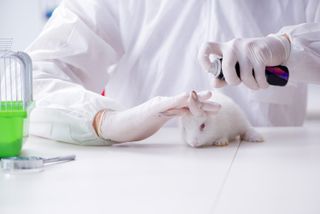Are There Options Other Than Animal Testing
What Are the Alternatives to Animal Testing?

In 1980, The New York Times featured a full-page advertisement from an beast rights group, which lambasted a prominent cosmetics visitor for testing its products on the eyes of rabbits. The campaign was so effective, it led to several dazzler companies pledging hundreds of thousands of dollars toward enquiry to find alternative testing methods that didn't involve animals.
Almost 40 years afterwards, what are some of these alternatives, and how much progress have we fabricated?
Before we delve into the respond, at that place's 1 of import distinction to make: although "animal testing" usually conjures up the prototype of defenseless rabbits existence prodded and poked in the name of beauty, the use of animals in research — and the search for alternatives — stretches far beyond the cosmetics industry. Animals like mice and rats are widely used in toxicology, the report of chemicals and their effects on us. Animals are also a crucial to drug discovery and testing. In biomedical research, creature models are the foundation of many experiments that help researchers investigate everything from the functioning of circuits in the encephalon to the progression of illness in cells. [Practise Animals Get Seasick?]
Despite their importance in these fields, there are now efforts to reduce the number of animals used in testing. That'southward due, in office, to ethical concerns that are driving new legislation in different countries. But it also comes downwards to money and time.
"In theory, non-fauna tests could be much cheaper and much faster," said Warren Casey, the director of the U.S. National Toxicology Programme's Interagency Heart for the Evaluation of Culling Toxicological Methods, which analyzes alternatives to animal use for chemical- safety testing.
Another business organization is that in some types of inquiry, animals are also different from humans to successfully predict the furnishings that certain products will take on our bodies. "So we've got ideals, efficiency and homo relevance," Casey told Alive Scientific discipline, the three main factors driving the chase for alternatives.
So, what are the most promising options so far?
Data, information, everywhere
Ane approach is to supplant animals with algorithms. Researchers are developing computational models that crunch huge quantities of research data to predict the effects of sure products on an organism.
"This is a very applicable approach. It'due south very cheap," said Hao Zhu, an associate professor of chemistry at Rutgers University in New Bailiwick of jersey. Zhu is part of a inquiry team that has developed a loftier-speed algorithm that extracts reams of information from online chemical databases, to compare thousands of tested chemical compounds with new, untested ones by identifying structural similarities between them. Then, information technology uses what we know virtually the toxicity of the tested compounds to brand reliable predictions almost the toxicity of the untested varieties with a similar structure (bold that this shared construction means the chemical compound volition have like effects).
Typically, identifying the effects of a new compound would require scores of expensive, time-consuming fauna tests. But computational predictions like this could help to lessen the amount of fauna research required. "If we can evidence that the chemical compound nosotros desire to put onto the market is safe, then I think these kinds of studies could be a replacement for current animate being studies," Zhu said. A similar study from researchers at Johns Hopkins University in Maryland showed that algorithms could even exist better than animal tests at predicting toxicity in various compounds. [How Psychedelic Drugs Create Such Weird Hallucinations]
Miniature organs
In contempo years, scientists have started growing cultured human cells on scaffolds embedded on plastic chips, forming tiny structures that mimic the operation of our heart, liver, kidneys and lungs. Known as organs-on-a-chip, these could provide a novel mode to test the furnishings of new compounds or drugs on homo cells.
Testing on these simplified, miniaturized versions of our physiology could deliver more man-relevant results than brute experiments. Crucially, the tests could too supervene upon the utilise of whole animals in the exploratory stages of early research, when scientists don't necessarily need to test on whole systems. Organs-on-a-bit "for the nearly part address a single output or endpoint," Casey said — because all that may be required at this early on stage is to test the behavior of one cell type in response to a drug or a disease, as a way to guide hereafter research.
This could "help in almost cases to reduce the amount of animal tests researchers are planning inside ongoing projects," said Florian Schmieder, a researcher who is working on that goal by developing miniature kidney and middle models at the Fraunhofer Institute for Textile and Beam Technology, in Germany. Besides as lungs, livers and hearts, some companies are developing bogus 3D structures that replicate man skin. That's specially of import in toxicology, where creature skin tests accept long been a baseline for understanding the effects of new, untested compounds.
Replacing this with a impairment-free model is at present a reality, Casey said: "Peel tissue models have really proven to be pretty effective. They can provide insight on the acute changes — whether something's going to be corrosive and impairment skin."
Man studies
One idea that's frequently raised as a counter to animal testing is that if humans want to benefit from new treatments, drugs and research, we should instead offer ourselves as the test subjects. That's quite a simplified and farthermost view — and in nearly countries animal tests are required by law before drugs are given to humans, for instance. So information technology isn't necessarily practical, either.
But, there are carefully controlled forms of man testing that do have the potential to reduce animal use, without endangering human health. Ane such method is microdosing, where humans receive a new drug in such tiny quantities that it doesn't take broad physiological impacts, however in that location'southward just enough circulating in the system to measure out its impact on individual cells.
The idea is that this cautious approach could assistance eliminate nonviable drugs at an early stage, instead of using thousands of animals in studies that may simply institute that a drug doesn't work. The approach has proved safe and effective enough that many major pharmaceutical companies now apply microdosing to streamline drug evolution. [Why Practise Medical Researchers Employ Mice?]
"In that location will of grade exist ethical concerns, but these could hands be outweighed past the potential gains in bringing safer and more effective medicines to market more efficiently," Casey said.
Where are nosotros now?
So, what exercise these alternatives mean for the future of fauna testing? In some areas of enquiry like cosmetics testing — where and then many existing products have already been proved safe through creature studies — at that place'due south a growing recognition that testing new products is something nosotros really don't need to accelerate this industry. That's borne out by regulations like the one put frontward by the European union, which at present bans animal testing on any cosmetic products that are produced and sold within the EU.
We're too seeing advances in toxicology research. Toxicologists have long relied on vi cadre animal-based tests that screen new products for acute toxicity — checking whether a product causes skin irritation, eye damage or death if consumed. But in the side by side two years, these baseline tests volition likely exist replaced with non-animal alternatives in the Us, Casey said. The reason for this progress is that the "biology underlying these types of toxicity is much simpler than other rubber concerns that can arise after [an animal is] exposed to a chemic for an extended menses of time, such as cancer or reproductive toxicity," Casey said.
But in other areas of research, where the questions being investigated are more circuitous, creature models still provide the only way we currently have of fully understanding the varied, widespread, long-term effects of a chemical compound, drug or illness. "Physiology is actually, really complex and we still don't take a handle on it" — nor annihilation that legitimately mimics it bated from animal models, Casey said.
Fifty-fifty despite the almost promising advances like the evolution of organs-on-a-chip, that'due south still a long manner from anything representing a connected human body. "The major problem in developing artificial organ systems is to gain the whole complexity of a living organism in vitro," Schmieder said. "The trouble hither is to emulate the kinetics and dynamics of the human body in a really predictive manner."
While organs-on-a-chip and other inventions might assist answer simpler questions, right now whole-beast models are the just way to study more complex furnishings — such as how excursion functions in the brain are linked to visible behaviors. These are the types of questions that aid us understand human affliction, and ultimately atomic number 82 to lifesaving treatments and therapies. So, the animal experiments that underlie those discoveries remain crucial. [Do Animals Take Feelings?]
Information technology'south likewise worth noting that some of the nigh promising non-animal tests we have today — like algorithms — work only because they can draw on decades of animal research. And to advance in the future, we volition demand to continue this inquiry, Zhu said.
"We can't utilize computers to totally replace animal testing. We still need some depression-level animal testing to generate the necessary data," Zhu said. "If you asked me to vote for a promising approach, I would vote for a combination of computational and experimental methods."
So, are there alternatives to animal testing? The brusk answer is yes — and no. While we have several options, for now they're not sophisticated enough to eradicate animal testing. Crucially, however, they can reduce the number of animals we use in inquiry. And with new regulations, and ever-smarter alternatives, nosotros tin can at least exist hopeful that in the time to come, the number of animals will continue to decline.
- Why Do Mice Poop And so Much?
- Do Animals Get Jealous?
- Do Animals Murder Each Other?
Originally published on Alive Science.
Source: https://www.livescience.com/65401-animal-testing-alternatives.html
Posted by: trantrive1970.blogspot.com


0 Response to "Are There Options Other Than Animal Testing"
Post a Comment